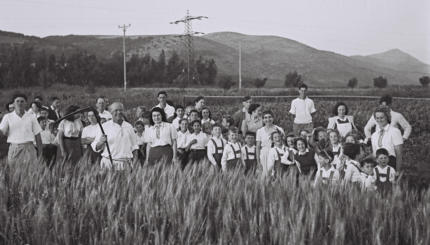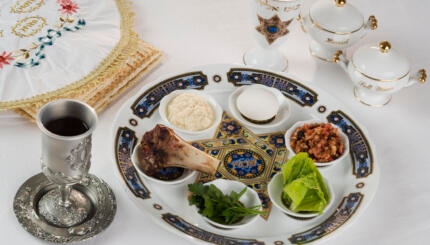This article highlights certain elements of the that occur after the meal. Among the items omitted here are the songs that take place at the very end of the seder. Reprinted with permission from A Different Night: The Family Participation Haggadah published by the Shalom Hartman Institute.
Afikoman: The Hidden Matzah
is a holiday celebrating our reunion with the lost parts of ourselves. Often, hiding and separation are essential stages in our life. In the Biblical story of the Exodus, both [Moses] and God played "hide-and-go-seek." Moshe was hidden for three months from Pharaoh until he was adopted by Pharaoh’s daughter. Then the grown Moshe went out to seek his brothers.
The divine face too was hidden for hundreds of years of servitude until God’s revelation to Moshe at the burning bush. Initially Moshe hid his face, but eventually he helped all Israel to encounter God face to face at Mount Sinai. On seder night, we hide and then seek the afikoman, reuniting the two parts separated at the beginning of the seder. May we learn to discover the lost parts of ourselves, to become reconciled with relatives who have become distant and to find wholeness in a Jewish tradition from which we have become alienated.
Elijah’s Cup
Now the seder focuses on the hope for the future redemption symbolized by Elijah the Prophet, bearer of good news.

Help us keep Jewish knowledge accessible to millions of people around the world.
Your donation to My Jewish Learning fuels endless journeys of Jewish discovery. With your help, My Jewish Learning can continue to provide nonstop opportunities for learning, connection and growth.
In Egypt, the doors of the house were shut tight on the night of the tenth plague. Blood marked the lintels of the doorposts where we now place the mezuzah. However, in the contemporary seder the doors are opened wide in expectation. This is no longer a night of terror but the dawn of hope. It is, as the calls it, a Night of Watching in expectation of great changes for the better.
The Hassidic rebbe Naftali Tzvi Horowitz (died 1817) used to invite all the participants of the seder–in order of their place at the table–to pour from their personal cups into Elijah’s cup. This symbolizes the need for everyone to make their own personal contribution to awaken the divine forces of redemption by beginning with human efforts (hee-to-ra-ruat dee-l’ta-ta) [Aramaic for "the awakening from below"].
In some families, each participant helps to fill Elijah’s cup of future redemption while expressing a particular wish for a better year.
Pour Out Your Wrath
As the seder comes to an end, not only do we recall the moment of the liberation from Egypt, but we also pray for redemption from our contemporary persecutors.
Hallel–Part 2
The Pesach seder is divided into two parts by the meal itself. In fact, Hallel (Psalms 113-118) itself is split. While the first half of the seder and of the Hallel (Psalms 113-114) is dedicated to the past, to historical memory of the redemption from Egypt, the second half looks forward to the future and ends with the wish "Next year in Jerusalem!" Messianic hope inspires the singing from now through the completion of the seder. Our mood is joyful anticipation of a better world.
In addition to the usual festival Hallel, on seder night we add the "Great Hallel" (Psalm 136). Both of them feature the famous refrain, "Give thanks to the Lord, for God is good! God’s kindness is forever!"
Some rabbis require or at least permit that an extra cup be drunk with the Great Hallel. Some people dedicate this fifth cup to the establishment of the State of Israel and the ingathering of the exiles. They see Pesach not only as a liberation from servitude but also as the first step to independence.
Counting the Omer
On the second night of Pesach we begin counting the 50 days from the Exodus to Sinai, from Pesach, the harvest of barley, to Shavuot, the harvest of wheat. Traditionally, the rabbis interpret the counting as reflecting Israel’s eager anticipation of the giving of the Torah at Sinai on Shavuot. The physical liberation is not an end in itself, but must be wedded to a life of values and responsibility.
Concluding the Seder
The Pesach seder ends with a prayer that all our efforts to perform the seder properly may be pleasing and acceptable to God. (The prayer was composed by Rabbi Yosef Tov-Elem, 11th century, France.)
Concluded is the Pesach Seder, finished down to the last detail with all its laws and customs. As we have been able to conduct this seder, so may we someday perform it in Jerusalem. Pure One who dwells in the palace, support your congregation countless in number. May you soon lead the offshoots of your stock, bringing the redeemed to Zion in joy.


